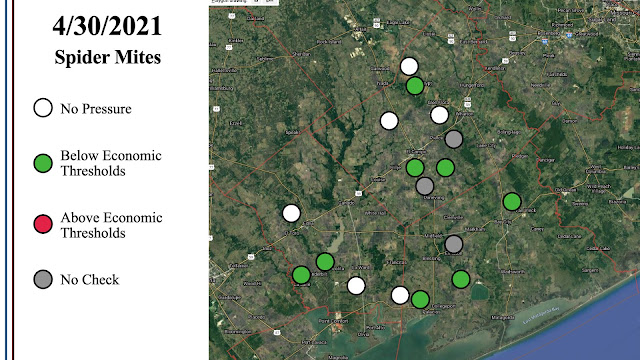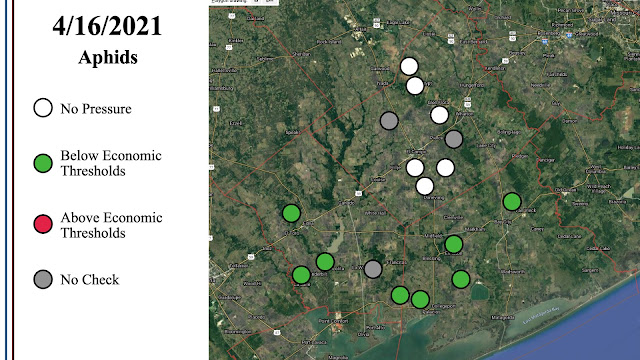Most of our replanted cotton is up and looking good now, and we got a good bit of rain last night but most of my fields were looking good, if dry and a bit wind burnt this week. Hopefully most of the dry places have gotten rain or will in the next day or so.
 |
Cotyledon Cotton Kate Crumley |
I have seen an increase in thrips numbers this week, and some insecticide applications have been made for thrips control. There have been light aphid numbers in most of the fields I looked at in Jackson and Matagorda county, and a few spider mites in all three counties, but all at levels far below the economic threshold. Below are charts with my scouting information for this past week, the week of 4/30/2021. If the locations were not checked, it was due to spray applications.

 |
| Western Flower Thrips Kate Crumley |
 |
| Tobacco Thrips Kate Crumley |
The insects are visible to the naked eye and scouting can be done by examining the plant, it is easy to miss some of the smaller larvae. Smacking a cotton plant around on the inside of a cup will knock them off and can make them easier to count. Cotton with a neonicotinoid seed treatment is usually safe from thrips for about 2-3 weeks after planting, depending on weather and soil types. Seedlings in sandier soil will typically lose the effect of seed treatments more quickly than those in heavier clay soils. Heavy rainfall can also reduce the amount of time a treatment is effective, while not enough water can impact the plant's uptake of the treatment and also cause a reduction in efficacy.
 |
| Thrips Damage Kate Crumley |
The economic threshold for thrips is 1 thrips per true leaf until the 5th true leaf stage. Once the plant reaches this stage, treatment for thrips is rarely justified.
 |
| Cotton Aphid Kate Crumley |
The threshold for cotton aphids is 50 aphids per leaf, and if you see aphid mummies in the field (tan or black dry and unmoving aphids), that's a good thing. Parasitoid wasps lay eggs in the aphids, and the aphid forms a mummy while the wasp larvae is pupating inside. These wasps, lady beetles, and lacewings can knock back aphid populations. Treatment for aphids is rarely justified, but if you do decide to treat for aphids, do not use a pyrethroid. Pyrethroids and organophosphates are broad spectrum, and kill beneficial insects as well as your target insect, but pests like aphids bounce back much quicker than their predators do. Their high reproductive rate will allow their numbers to soar after a broad spectrum insecticide application kills all their predators.
 |
| Aphid Mummies on Cotton Kate Crumley |
Spider mite populations rarely get high enough to treat, as they thrive in drier climates and we tend to be fairly humid. Treatment is justified when spider mites are causing visible defoliation.
 |
| Spider Mites on Cotton Kate Crumley |
 |
| Cotton Fleahopper Adult Kate Crumley |
I've seen a few fleahoppers this week, but not in squaring cotton yet. Next week I plan to start checking for fleahoppers in fields with squares.
Fleahopper feeding will cause squares to drop. Plants can recover for and compensate for some square loss, but the threshold for fleahoppers is 15-25 per 100 plants. I check for fleahoppers by inspecting the plant terminals once they start squaring. I look at 25 plants per stop in the field, usually checking 100 plants total in an 80-100 acre field, more if the field is larger. Fleahopper nymphs can be close to the size of aphids, but look like smaller versions of the adults without wings, and are much more mobile than aphids.
The chart below contains insecticide suggestions from cottonbugs.tamu.edu (also a good resource) for reference if you have fleahoppers at the action threshold in the upcoming weeks.
Please check out our weekly IPM Audio Updates, the website to sign up to receive those is listed below. If you have any questions feel free to contact me either by email or calling the office. Have a good weekend everyone!
Check out our weekly IPM Audio Updates
Plant Population Evaluation
Making Replant Decisions in Cotton
Cotton Insect Management Guide
Development and Growth Monitoring of the Cotton Plant
















